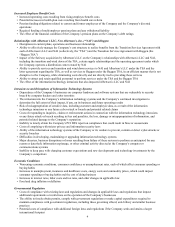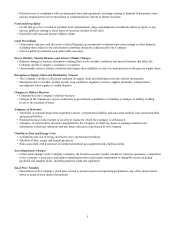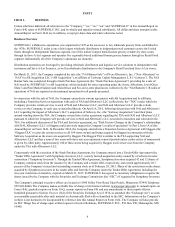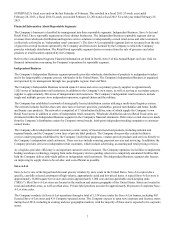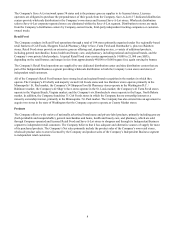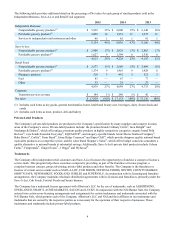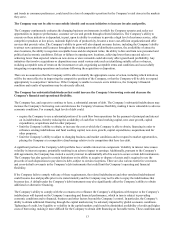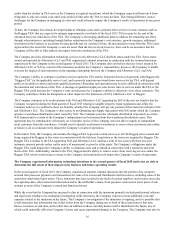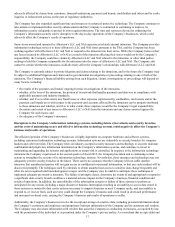Albertsons 2015 Annual Report Download - page 16
Download and view the complete annual report
Please find page 16 of the 2015 Albertsons annual report below. You can navigate through the pages in the report by either clicking on the pages listed below, or by using the keyword search tool below to find specific information within the annual report.14
factors may also negatively impact the Company’s debt ratings, which may increase the cost of borrowing, adversely affect the
Company’s ability to access one or more financial markets or result in a default under the Company’s debt instruments.
Any of these outcomes may adversely affect the Company’s financial condition and results of operations.
Failure to maintain satisfactory labor relations could adversely affect the Company’s financial condition and results of
operations.
As of February 28, 2015, the Company is a party to 49 collective bargaining agreements covering approximately 16,000 of its
employees, of which eight collective bargaining agreements covering approximately 1,200 employees are scheduled to expire
in fiscal 2016. In addition, during fiscal 2015, 19 collective bargaining agreements covering approximately 11,700 employees
were renegotiated. In fiscal 2015, four collective bargaining agreements covering approximately 800 employees expired
without their terms being renegotiated. Negotiations are expected to continue with the bargaining units representing the
employees subject to those agreements. In future negotiations with labor unions, the Company expects that, among other issues,
rising healthcare, pension and employee benefit and wage costs and operational flexibility will be important topics for
negotiation. There can be no assurance that the Company will be able to negotiate the terms of expiring or expired agreements
in a manner acceptable to the Company. Therefore, potential increases in operating costs or work disruptions from labor
disputes could disrupt the Company’s businesses and adversely affect the Company’s financial condition and results of
operations. Certain of the Company’s operations have employees who are non-union, and while the Company believes its
employee relations are strong, there can be no assurance that these operations will not experience pressure from labor unions or
become the target of campaigns to unionize.
Increased healthcare, pension and other costs under the Company’s and multiemployer benefit plans could adversely
affect the Company’s financial condition and results of operations.
The Company provides health benefits to many of its employees and the costs to provide such benefits continue to increase
annually. The amount of any increase or decrease in the cost of Company-sponsored health plans will depend on a number of
different factors, many of which are beyond the Company’s control, such as The Patient Protection and Affordable Care Act,
which has resulted in changes to the U.S. healthcare system. The Patient Protection and Affordable Care Act imposes new
mandatory types of coverage and reporting and other requirements on Company-sponsored health plans, which have increased
and the Company expects will continue to increase the Company’s health plan costs over time.
The Company also sponsors defined benefit pension, defined contribution pension, and other postretirement benefit plans for
substantially all employees not participating in multiemployer health and pension plans. The Company’s costs to provide such
benefits generally continue to increase annually. The Company uses actuarial valuations to determine the Company’s benefit
obligations for certain benefit plans, which require the use of significant estimates, including the discount rate, expected long-
term rate of return on plan assets, mortality rates and the rates of increase in compensation and health care costs. Changes to
these significant estimates could increase the cost of these plans, which could also have a material adverse effect on the
Company’s financial condition and results of operations.
The defined benefit pension plan sponsored by the Company is for pension obligations to current and former employees of the
Company as well as some of its divested businesses. The Company’s defined benefit pension plan was closed for eligibility and
frozen for credited benefit service for the vast majority of participants effective December 2007. In December 2012, that plan
was frozen as to credited service and earnings for the vast majority of participants and, effective March 21, 2013 the plan was
frozen for all remaining participants, although vesting service may continue to accrue. Participants who were employed by the
Company or NAI on March 21, 2013 became vested in their pension plan benefit under the Company’s defined benefit plan.
Service at the Company (but not service at NAI) after that date will count toward eligibility for early retirement if applicable
under the pension plan formula.
The projected benefit obligations of the Company-sponsored plans exceed the fair value of those plans’ assets. Required
contributions could increase due to a variety of factors, including lower pension discount rates, increased levels of
underfunding, new mortality tables and new legislation.
Additionally, if the Company is unable to control healthcare benefits and pension costs, the Company may experience increased
operating costs, which may adversely affect the Company’s financial condition and results of operations.
In addition, the Company participates in various multiemployer health and pension plans for a majority of its union-affiliated
employees, and the Company is required to make contributions to these plans in amounts established under collective
bargaining agreements. The costs of providing benefits through such plans have increased in recent years. The amount of any


